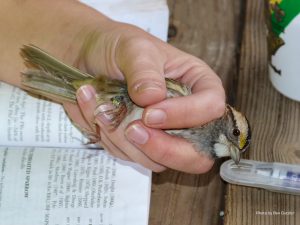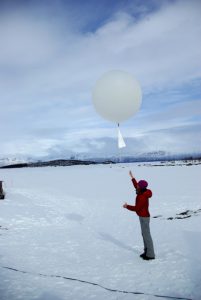
Joe with a Trumpeter Swan.
The activities are as follows:
- Teacher Guide
- Student activity, Graph Type A, Level 3
- Student activity, Graph Type B, Level 3
- Student activity, Graph Type C, Level 3
- Grading Rubric
- Digital Data Nugget on DataClassroom
The Kellogg Bird Sanctuary was created in 1927 to provide safe nesting areas for waterfowl such as ducks, geese, and swans. During that time many waterfowl species were in trouble due to overhunting and the loss of wetland habitats. One species whose populations had declined a lot was the Trumpeter Swan. Trumpeter swans are the biggest native waterfowl species in North America. At one time they were found across North America, but by 1935 there were only 69 known individuals in the continental U.S.! The swans were no longer found in Michigan.
The reintroduction, or release of a species into an area where they no longer occur, is an important tool in helping them recover. In the 1980s, many biologists came together to create a Trumpeter Swan reintroduction plan. Trumpeter Swans in North America can be broken up into three populations – Pacific Coast, Rocky Mountain, and Interior. The Interior is further broken down into Mississippi/Atlantic and High Plains subpopulations. Joe, the Kellogg Bird Sanctuary manager and chief biologist, wrote and carried out a reintroduction plan for Michigan. Michigan is part of the Mississippi/Atlantic subpopulation. Joe and a team of biologists flew to Alaska in 1989 to collect swan eggs to be reared at the sanctuary. After two years the swans were released throughout Michigan.
The North American Trumpeter Swan survey has been conducted approximately every 5 years since 1968 as a way to estimate the number of swans throughout their breeding range. The survey is conducted in late summer when young swans can’t yet fly but are large enough to count. Although the surveys are conducted across North America, the data provided focuses on just the Interior Population, which includes swans in the High Plains and Mississippi/Atlantic Flyways.
Featured scientist: Wilbur C. “Joe” Johnson from the W.K. Kellogg Bird Sanctuary. Written by: Lisa Vormwald and Susan Magnoli from Michigan State University.
Flesch–Kincaid Reading Grade Level = 11.5
- The 2015 North American Trumpeter Swan Survey
- Current conservation efforts in North America – The Trumpeter Swan Society
- The comeback story of Michigan’s native Trumpeter Swans – Michigan Radio
- Learn more about trumpeter Swan natural history here and here.
- A New York Times article from 1987 on Trumpeter Swan reintroduction in Michigan
- Article from The Outdoor Journal on Trumpeter Swan recovery in Michigan
- Use eBird, a database of citizen science bird sightings, to look for Trumpeters near you
- Learn more about the Kellogg Bird Sanctuary
A video on Trumpeter Swan reintroduction efforts that could be shown before the Data Nugget to engage students with the topic, or after to expand the research beyond the one study:









 About Kristine: Kristine L. Grayson is an Associate Professor in the Biology Department at University of Richmond, where she teaches Intro Ecology/Evolution, Field Ecology, Ecophysiology, and
About Kristine: Kristine L. Grayson is an Associate Professor in the Biology Department at University of Richmond, where she teaches Intro Ecology/Evolution, Field Ecology, Ecophysiology, and 



















